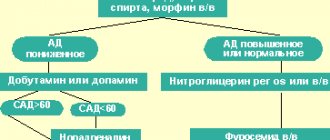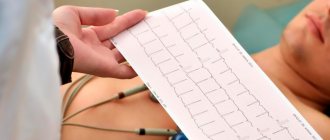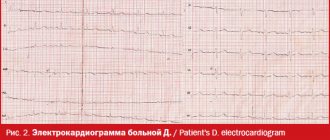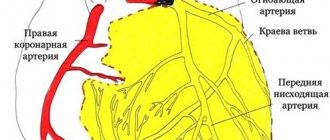Acute heart failure
Acute heart failure is one of the most dangerous conditions in cardiological practice. This is the final stage in the development of all progressive heart diseases. In acute heart failure, the pumping function of the heart quickly decreases, and therefore its ability to supply tissues and organs with blood and oxygen. The main threat of acute heart failure is death.
- Emergency care at Ilyinsky Hospital
Ilyinskaya Hospital is ready to provide emergency cardiac care around the clock. One of the key skills of our specialists is the correct strategy for managing patients with acute heart failure. If there are indications, the patient will urgently undergo endovascular surgery to stent the coronary arteries. The Ilyinskaya Hospital has a cardiac intensive care unit. Invasive monitoring methods are used when catheters are installed in the cavity of the heart, allowing one to respond to changes in its functioning much earlier than the patient feels it and take the right proactive actions.
- Causes of acute heart failure
There are many causes of acute heart failure. The most common is myocardial infarction. After coronary artery thrombosis, a large fragment of the heart muscle dies, and the power of the “main motor” decreases. Other causes may be diseases of the heart muscle: hereditary diseases (cardiomyopathies), diseases associated with inflammation - myocarditis, progressive alcoholic heart disease. Also among the causes are various valve defects, which can occur with minimal clinical symptoms for a very long time. If you do not resort to cardiac surgery, valve defects can manifest as acute heart failure (or decompensation of chronic heart failure, depending on the type of defect). In simple terms, acute heart failure is the end point in the development of almost all heart diseases and is often the immediate cause of death if very complex treatment is not provided in time.
There is another interesting type of heart failure. With it, the heart as a whole can supply the organs with blood in a more or less adequate manner. But this is given to him by an increase in pressure in one of the chambers - in our “main pump”, in the left ventricle. In this situation, the pressure in the pulmonary circulation increases sharply - in the vessels of the lungs. Severe shortness of breath and pulmonary edema occur. A person can die with formally normal cardiac output.
This type of heart failure is difficult to track because changes on the cardiogram are minimal, the pumping function of the heart is normal, and a catastrophe occurs in the blood vessels of the lungs. Today there are many such patients, since long-term hypertension
If left untreated, it leads to this type of heart failure.
And it is very different from another type of heart failure, in which there is a decrease in the pumping function of the heart - for example, with a heart attack
.
- Treatment of acute heart failure
A patient with acute heart failure should be observed in the intensive care unit. Treatment of such patients is difficult.
Medications.
If there is serious damage, it is not always possible to support heart function with medications. The actions of cardiac resuscitators can be compared to the actions of a virtuoso violinist who is trying to adjust the heart rate, cardiac output, dilate or constrict blood vessels differently in different regions and ensure normal blood flow to the heart vessels by regulating acceptable blood pressure. To successfully treat a patient with acute heart failure, the cardiac intensivist must consider a huge number of factors.
Stenting.
If the cause of acute heart failure was a myocardial infarction, stenting can be performed to eliminate the clot and restore blood flow.
Of course, provided that we manage to do this in the next 12 to 24 hours after the development of thrombosis, when the heart cells are still alive. To learn more.
Extracorporeal membrane oxygenation.
A situation often occurs when the condition of the heart muscle is so severe that there is simply no target for the action of medications. In the West, various devices to support blood circulation are actively used in such patients. In particular, you can take venous blood from a person and run it into a special device that will enrich it with oxygen. Such blood is poured into a person’s veins, then enters the lungs and is further enriched with oxygen. This way the total amount of oxygen in the blood will increase and save a person’s life. This technology is called extracorporeal membrane oxygenation.
Artificial left ventricle.
You can install a special device inside the heart that takes over part of the function of the left ventricle. These devices may be temporary or permanent. We are talking about an artificial left ventricle, which is now being actively installed in the West. Russian scientists from Zelenograd have established the production of left ventricles of very decent quality. Placement of an artificial left ventricle in a patient with acute heart failure may be a last resort. The person will live with him as long as possible. Or it may be a temporary measure until a heart transplant is performed. Models of artificial left ventricles can work for several years. However, this is a short period of time for a young person, and such patients often require a heart transplant.
Rehabilitation for cardiovascular diseases
1. Introduction.
Rehabilitation of patients with cardiovascular diseases is one of the most pressing tasks of modern medicine, because This pathology ranks first among other causes of mortality. It is no secret that any disease of the circulatory system leads to disruption of the function of organs and systems, the oxygen transport system, the heart muscle and the brain are disrupted, as the most sensitive and sensitive organs to oxygen deficiency begin to react to this. At the initial stage, this is manifested by a decrease in physical activity and human performance.
2. The principle of operation of the rehabilitation program.
The therapeutic and preventive effect of therapeutic exercises or physical therapy for cardiovascular diseases is due to the acceleration of lymph and blood flow, an increase in circulating blood volume (CBV), acceleration of metabolism in tissues, improvement of microcirculation, normalization of blood pressure, improvement of cognitive functions, acceleration of regeneration of damaged tissues and as a consequence, normalization of a person’s functional and psycho-emotional status (sleep, mood, etc.).
3. Stages of rehabilitation.
Before moving on to the stages of exercise therapy for cardiovascular diseases
already existing in the patient, it is necessary to note the importance of preventing this pathology and in this context one should understand the importance of carrying out hygienic therapeutic exercises at home (morning exercises) and in working conditions (five-minute exercise sessions).
- Stage 1 - Carrying out exercise therapy in the acute period. As a rule, classes are held exclusively in gentle modes (lying down, sitting) with a gradual expansion of the mode and load. The decision on the level of load is made by the rehabilitation specialist together with the attending physician (therapist, cardiologist, neurologist).
- Stage 2 - Carrying out exercise therapy during the recovery period. During this period, at the discretion of the rehabilitation physician, the regime is expanded and classes are conducted in sitting and standing positions, and non-forced walking on a horizontal surface is allowed. Further, if the course of the recovery period is favorable, patients are given fractional walking along the steps, mainly from top to bottom, and then assessing the degree of cardio load from bottom to top. Includes classes in the pool or on exercise machines, etc.
- Stage 3 - Supportive. The main task in this period is to stabilize and strengthen the patient’s acquired skills developed during the previous stages of rehabilitation. An increase in his performance and endurance, tolerance to stress and, as a result, a maximum “return” to his previous physical, psycho-emotional and social status.
ONLINE CONSULTATIONS More details
4. Contraindications.
Contraindications, as well as the prescription of physical therapy for cardiovascular diseases
determined by a rehabilitation doctor! And this largely depends on the severity of the underlying disease and the presence of complications.
But there are also absolute contraindications to performing exercise therapy with this category of patients, namely, the following are prohibited:
- breath holding exercises
- prolonged or sudden head tilts
- jumping
- no fractional load
- classes in stuffy, unventilated rooms
- too early or late class hours
- supplying excessive cardio load (stepper, climbing treadmill), etc.
5. Indications for physical therapy for cardiovascular diseases.
- Arterial hypotension (hypotension)
- Vertebrobasilar insufficiency (VBI)
- Transient cerebrovascular accidents (TCI) and conditions after acute cerebrovascular accidents (ACVA)
- Coronary heart disease (CHD)
- Angina pectoris
- Previous myocardial infarction (MI)
- Myocarditis, pericarditis
- Cardiac arrhythmias
- Heart failure (HF)
- Rheumatism
- Congenital and acquired heart defects
- Atherosclerosis
6. Conclusion.
Of course, you need to understand that rehabilitation measures, including exercise therapy, for cardiovascular diseases
are not the only method of treating patients, but require a comprehensive analysis and inclusion of basic and auxiliary treatment methods such as surgical, microsurgical, physiotherapy, massage, pharmacotherapy, etc. Only in conjunction with modern treatment methods can physical therapy be effective and lead to desired result.
Our clinic has a department of rehabilitation and restorative medicine, where patients can fully recover and those who are healthy can relax. There are caring doctors here who will help you cope with back pain and stiffness after injuries to bones, joints, muscles, and ligaments. Rehabilitation specialists are ready to help people after a stroke, children and adults with cerebral palsy, and patients with other neurological diseases.
An online rehabilitation format is also available for adults, children over 10 years old, pregnant and nursing mothers. We will help you organize classes and consultations with doctors so that you can stay at home.









